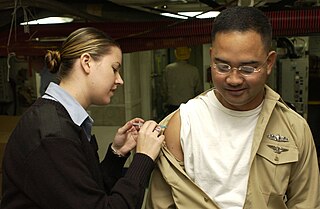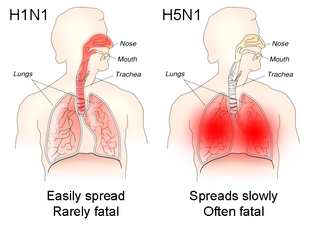
A pandemic is an epidemic of an infectious disease that has spread across a large region, for instance multiple continents or worldwide, affecting a substantial number of individuals. Widespread endemic diseases with a stable number of infected individuals such as recurrences of seasonal influenza are generally excluded as they occur simultaneously in large regions of the globe rather than being spread worldwide.

Influenza vaccines, colloquially known as flu shots, are vaccines that protect against infection by influenza viruses. New versions of the vaccines are developed twice a year, as the influenza virus rapidly changes. While their effectiveness varies from year to year, most provide modest to high protection against influenza. Vaccination against influenza began in the 1930s, with large-scale availability in the United States beginning in 1945.
The Hong Kong flu, also known as the 1968 flu pandemic, was a flu pandemic whose outbreak in 1968 and 1969 killed between one and four million people globally. It is among the deadliest pandemics in history, and was caused by an H3N2 strain of the influenza A virus. The virus was descended from H2N2 through antigenic shift, a genetic process in which genes from multiple subtypes are reassorted to form a new virus.

Swine influenza is an infection caused by any of several types of swine influenza viruses. Swine influenza virus (SIV) or swine-origin influenza virus (S-OIV) refers to any strain of the influenza family of viruses that is endemic in pigs. As of 2009, identified SIV strains include influenza C and the subtypes of influenza A known as H1N1, H1N2, H2N1, H3N1, H3N2, and H2N3.

Flu season is an annually recurring time period characterized by the prevalence of an outbreak of influenza (flu). The season occurs during the cold half of the year in each hemisphere. It takes approximately two days to show symptoms. Influenza activity can sometimes be predicted and even tracked geographically. While the beginning of major flu activity in each season varies by location, in any specific location these minor epidemics usually take about three weeks to reach its pinnacle, and another three weeks to significantly diminish.

In virology, influenza A virus subtype H1N1 (A/H1N1) is a subtype of influenza A virus. Major outbreaks of H1N1 strains in humans include the 1918 Spanish flu pandemic, the 1977 Russian flu pandemic and the 2009 swine flu pandemic. It is an orthomyxovirus that contains the glycoproteins hemagglutinin (H) and neuraminidase (N), antigens whose subtypes are used to classify the strains of the virus as H1N1, H1N2 etc. Hemagglutinin causes red blood cells to clump together and binds the virus to the infected cell. Neuraminidase is a type of glycoside hydrolase enzyme which helps to move the virus particles through the infected cell and assist in budding from the host cells.

An influenza pandemic is an epidemic of an influenza virus that spreads across a large region and infects a large proportion of the population. There have been six major influenza epidemics in the last 140 years, with the 1918 flu pandemic being the most severe; this is estimated to have been responsible for the deaths of 50–100 million people. The 2009 swine flu pandemic resulted in under 300,000 deaths and is considered relatively mild. These pandemics occur irregularly.
The National Center for Immunization and Respiratory Diseases (NCIRD), formerly known as the National Immunization Program until April 2006, is charged with responsibility for the planning, coordination, and conduct of immunization activities in the United States. NCIRD is a part of the Centers for Disease Control and Prevention, located in Atlanta, Georgia, and housed in the CDC's Coordinating Center for Infectious Diseases (CCID). The National Center for Immunization provides consultation, training, statistical, promotional, educational, epidemiological, and technical services to assist state and local health departments across the US in planning, developing, contracting and implementing immunization programs.

Influenza-like illness (ILI), also known as flu-like syndrome or flu-like symptoms, is a medical diagnosis of possible influenza or other illness causing a set of common symptoms. These include fever, shivering, chills, malaise, dry cough, loss of appetite, body aches, nausea, and sneezing typically in connection with a sudden onset of illness. In most cases, the symptoms are caused by cytokines released by immune system activation, and are thus relatively non-specific.

The 2009 swine flu pandemic, caused by the H1N1/swine flu/influenza virus and declared by the World Health Organization (WHO) from June 2009 to August 2010, is the third recent flu pandemic involving the H1N1 virus. The first known human case was in La Gloria, Mexico, a rural town in Veracruz. The virus appeared to be a new strain of H1N1 that resulted from a previous triple reassortment of bird, swine, and human flu viruses which further combined with a Eurasian pig flu virus, leading to the term "swine flu".
The 2009 flu pandemic in the United States was caused by a novel strain of the Influenza A/H1N1 virus, commonly referred to as "swine flu", that was first detected on 15 April 2009. While the 2009 H1N1 virus strain was commonly referred to as "swine flu", there is no evidence that it is endemic to pigs or of transmission from pigs to people; instead, the virus spreads from person to person. On April 25, the World Health Organization declared a public health emergency, followed concurringly by the Obama administration on April 26.

This article covers the chronology of the 2009 novel influenza A (H1N1) pandemic. Flag icons denote the first announcements of confirmed cases by the respective nation-states, their first deaths, and relevant sessions and announcements of the World Health Organization (WHO), the European Union , and the U.S. Centers for Disease Control (CDC).

In 1976, an outbreak of the swine flu, influenza A virus subtype H1N1 at Fort Dix, New Jersey caused one death, hospitalized 13, and led to a mass immunization program. After the program began, the vaccine was associated with an increase in reports of Guillain–Barré syndrome (GBS), which can cause paralysis, respiratory arrest, and death. The immunization program was ended after approximately 25% of the population of the United States had been administered the vaccine.

The pandemic H1N1/09 virus is a swine origin influenza A virus subtype H1N1 strain that was responsible for the 2009 swine flu pandemic. This strain is often called swine flu by the public media. For other names, see the Nomenclature section below.

The 2009 swine flu pandemic in North America, part of a pandemic in 2009 of a new strain of influenza A virus subtype H1N1 causing what has been commonly called swine flu, began in the United States or Mexico.

The 2009 swine flu pandemic vaccines were influenza vaccines developed to protect against the pandemic H1N1/09 virus. These vaccines either contained inactivated (killed) influenza virus, or weakened live virus that could not cause influenza. The killed virus was injected, while the live virus was given as a nasal spray. Both these types of vaccine were produced by growing the virus in chicken eggs. Around three billion doses were produced, with delivery in November 2009.

The Centers for Disease Control and Prevention (CDC) estimates that, as of April 4, 2020, the 2019–2020 United States flu season had caused 39 million to 56 million flu illnesses, 410,000 to 740,000 hospitalizations and 24,000 to 62,000 deaths. In January 2020, the Director of the National Institute of Allergies and Infectious Diseases, Dr. Anthony Fauci expected the 2019–2020 flu season to be one of the worst in several years, at least as severe as the 2017–2018 season. By the third week in February the seasonal flu was near its peak with over 26 million people sickened, 250,000 hospitalized, and 14,000 who died. Experts said that the flu came in two waves, with a hard impact on children. The season began in October, earlier than usual, with the expected wave of influenza B virus. The number of children who died, 105, was higher in late February than any season for the past ten years with about 67% associated with influenza B viruses. The second wave came with the influx of influenza A viruses, such as H1N1. According to preliminary burden estimates for the 2019–2020 flu season there were between 39 and 56 million flu cases; 18–26 million doctor visits; 410,000 to 740,000 hospitalizations, and between 24,000 and 62,000 deaths. The unusually abrupt decline in cases by April 2020 was attributed to the effects of widespread social distancing and lockdowns aimed at COVID-19, shortening the influenza season by 5–6 weeks.

Arnold Monto is an American physician and epidemiologist. At the University of Michigan School of Public Health, Monto is the Thomas Francis, Jr. Collegiate Professor Emeritus of Public Health, professor emeritus of both epidemiology and global public health, and co-director of the Michigan Center for Respiratory Virus Research & Response. His research focuses on the occurrence, prevention, and treatment of viral respiratory infections in industrialized and developing countries' populations.

The COVID-19 pandemic has had many impacts on global health beyond those caused by the COVID-19 disease itself. It has led to a reduction in hospital visits for other reasons. There have been 38 per cent fewer hospital visits for heart attack symptoms in the United States and 40 per cent fewer in Spain. The head of cardiology at the University of Arizona said, "My worry is some of these people are dying at home because they're too scared to go to the hospital." There is also concern that people with strokes and appendicitis are not seeking timely treatment. Shortages of medical supplies have impacted people with various conditions.
Lyn Finelli is an American epidemiologist and infectious disease researcher, who helped lead the U.S. response to the 2009 H1N1 epidemic and contributed to research and public health communication about the COVID-19 pandemic. In 1990 Finelli was granted a doctorate in infectious disease epidemiology from Columbia University. She worked as chief of influenza surveillance and outbreak response at the Center for Disease Control. She led the CDC's response to the 2009 H1N1 outbreak and oversaw 200 employees. She was widely quoted in news coverage about the epidemic. Finelli now serves as executive director of new vaccine development at Merck Research Laboratories. In late March 2020, Finelli co-authored a paper published in the New England Journal of Medicine defining the epidemiology of COVID-19 and calling for further studies. Throughout her career, she has written over 100 scientific papers, book chapters, and articles on a variety of public health related topics, including RSV, sexual health, pneumonia, and hepatitis c.












